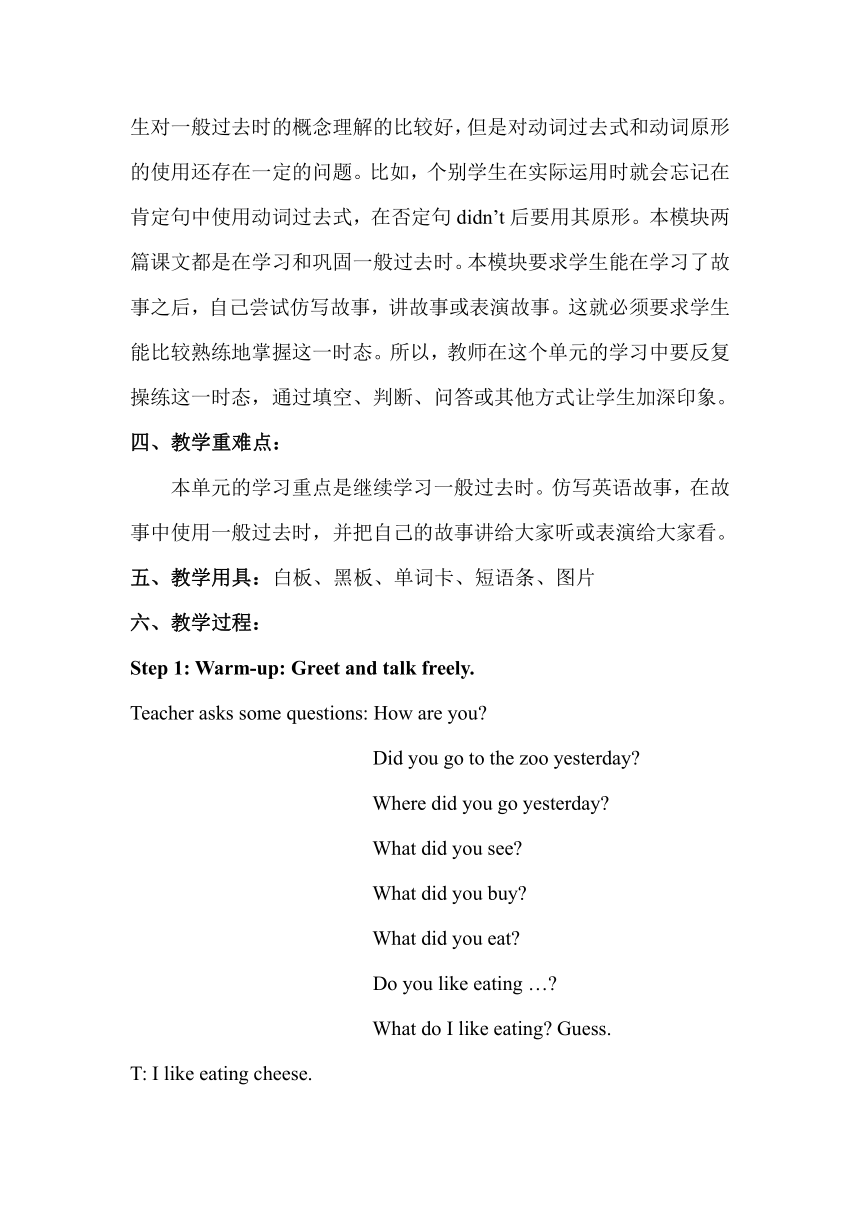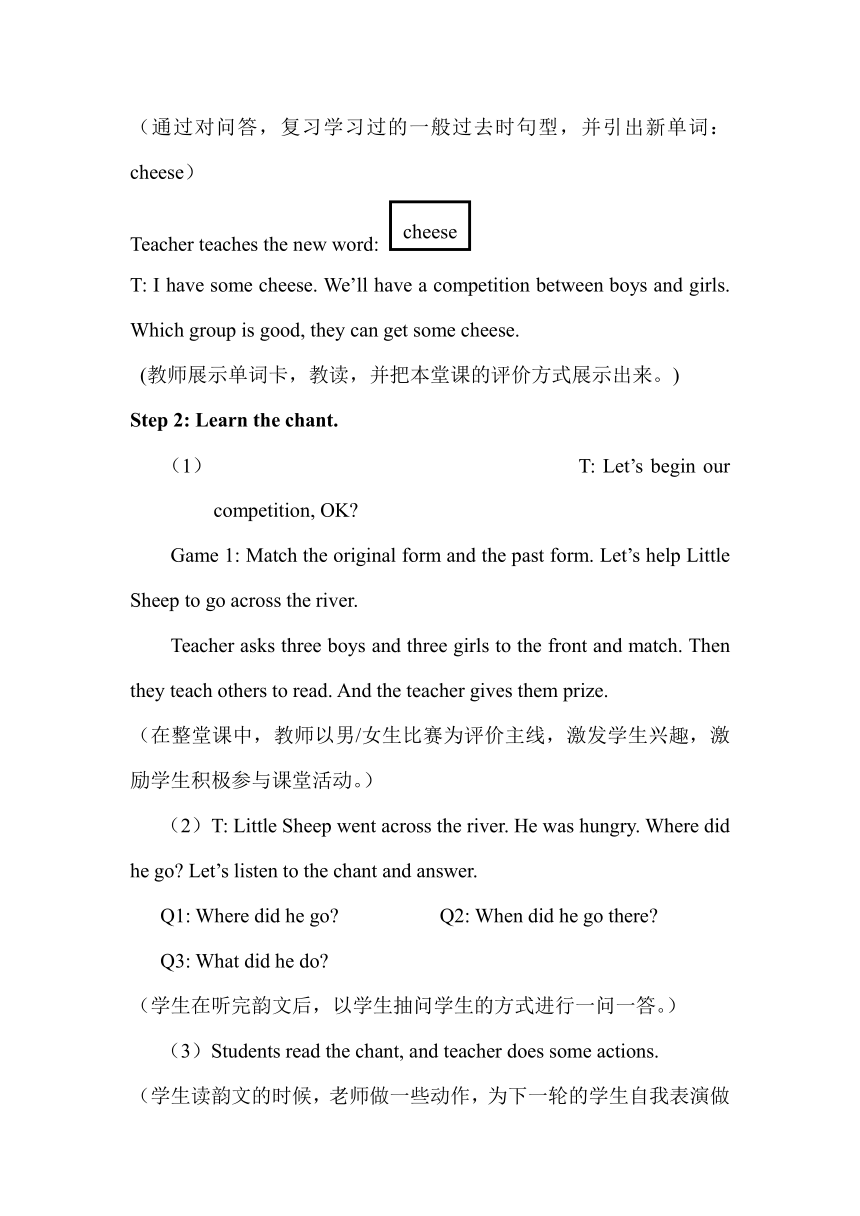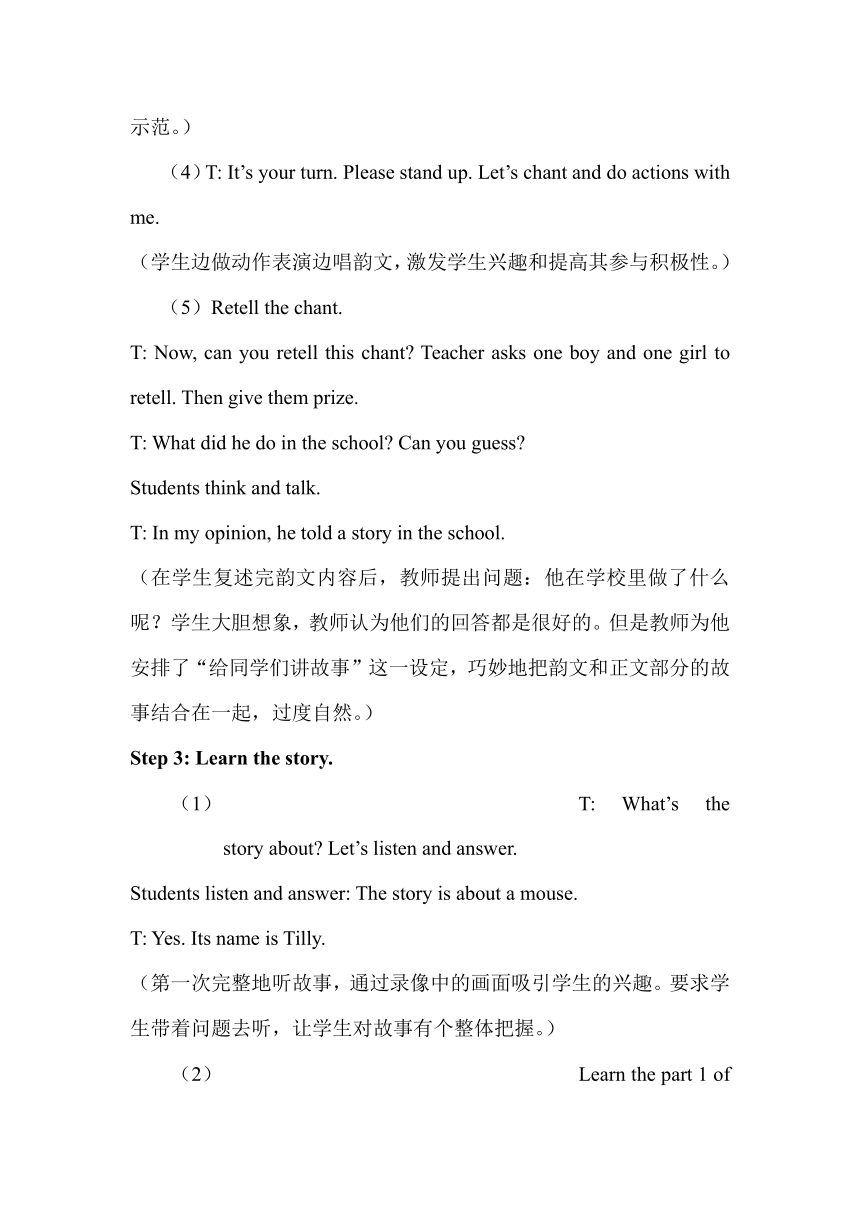Module 3 Unit 2 She went into a shop. 教案
文档属性
| 名称 | Module 3 Unit 2 She went into a shop. 教案 |  | |
| 格式 | doc | ||
| 文件大小 | 431.5KB | ||
| 资源类型 | 教案 | ||
| 版本资源 | 外研版(一年级起点) | ||
| 科目 | 英语 | ||
| 更新时间 | 2022-03-26 21:45:36 | ||
图片预览




文档简介
Module 3 Unit 2 She went into a shop.
一、教学目标:
语言知识目标 功能 用英语讲故事
语法 能够运用:She went into a shop.She bought some …She ate the…She saw …She was scared and ran away.
词汇 能够掌握新单词和短语:cheese/ month/ into/ scared/ ran away的发音与用法;复习前一单元中的shouted/ wouldn’t的用法
语音 进一步强化已学语音
语言技能目标 听 能够听懂:She went into a shop.She bought some …She ate …She saw …She was scared and ran away.
说 能说: She went into a shop.She bought some …She ate …She saw …She was scared and ran away.
读 能认读:cheese/ month/ into/ scared/ ran away,以及动词原形和对应的动词过去式
写 能写出与本模块主题相关的语句
运用 学生能运用已学一般过去时相关语言讲故事和仿写。
学习策略 学生尝试阅读和仿写英语故事。
文化意识 在学习和日常交际中,学生能初步注意中外文化的异同。
情感态度 学生积极尝试使用英语仿写故事,讲故事或表演故事。
任务 学生两人一组仿写故事,并尝试讲故事或表演出来。
二、教学内容分析:
本单元的主要内容是用英语讲故事。
课文情境是小老鼠Tilly的故事。Tilly去食品店买奶酪,买完之后才发现店主居然是一只大猫!
三、学情分析:
四年级的学生已经学习了接近一个半学期的一般过去时。班上学生对一般过去时的概念理解的比较好,但是对动词过去式和动词原形的使用还存在一定的问题。比如,个别学生在实际运用时就会忘记在肯定句中使用动词过去式,在否定句didn’t后要用其原形。本模块两篇课文都是在学习和巩固一般过去时。本模块要求学生能在学习了故事之后,自己尝试仿写故事,讲故事或表演故事。这就必须要求学生能比较熟练地掌握这一时态。所以,教师在这个单元的学习中要反复操练这一时态,通过填空、判断、问答或其他方式让学生加深印象。
四、教学重难点:
本单元的学习重点是继续学习一般过去时。仿写英语故事,在故事中使用一般过去时,并把自己的故事讲给大家听或表演给大家看。
五、教学用具:白板、黑板、单词卡、短语条、图片
六、教学过程:
Step 1: Warm-up: Greet and talk freely.
Teacher asks some questions: How are you
Did you go to the zoo yesterday
Where did you go yesterday
What did you see
What did you buy
What did you eat
Do you like eating …
What do I like eating Guess.
T: I like eating cheese.
(通过对问答,复习学习过的一般过去时句型,并引出新单词:cheese)
Teacher teaches the new word:
T: I have some cheese. We’ll have a competition between boys and girls. Which group is good, they can get some cheese.
(教师展示单词卡,教读,并把本堂课的评价方式展示出来。)
Step 2: Learn the chant.
(1) T: Let’s begin our competition, OK
Game 1: Match the original form and the past form. Let’s help Little Sheep to go across the river.
Teacher asks three boys and three girls to the front and match. Then they teach others to read. And the teacher gives them prize.
(在整堂课中,教师以男/女生比赛为评价主线,激发学生兴趣,激励学生积极参与课堂活动。)
(2)T: Little Sheep went across the river. He was hungry. Where did he go Let’s listen to the chant and answer.
Q1: Where did he go Q2: When did he go there
Q3: What did he do
(学生在听完韵文后,以学生抽问学生的方式进行一问一答。)
(3)Students read the chant, and teacher does some actions.
(学生读韵文的时候,老师做一些动作,为下一轮的学生自我表演做示范。)
(4)T: It’s your turn. Please stand up. Let’s chant and do actions with me.
(学生边做动作表演边唱韵文,激发学生兴趣和提高其参与积极性。)
(5)Retell the chant.
T: Now, can you retell this chant Teacher asks one boy and one girl to retell. Then give them prize.
T: What did he do in the school Can you guess
Students think and talk.
T: In my opinion, he told a story in the school.
(在学生复述完韵文内容后,教师提出问题:他在学校里做了什么呢?学生大胆想象,教师认为他们的回答都是很好的。但是教师为他安排了“给同学们讲故事”这一设定,巧妙地把韵文和正文部分的故事结合在一起,过度自然。)
Step 3: Learn the story.
(1) T: What’s the story about Let’s listen and answer.
Students listen and answer: The story is about a mouse.
T: Yes. Its name is Tilly.
(第一次完整地听故事,通过录像中的画面吸引学生的兴趣。要求学生带着问题去听,让学生对故事有个整体把握。)
(2) Learn the part 1 of the story.(学习故事的第一部分)
Listen to the part 1 of the story and choose tick or cross.
T: Before listening, there are two new words.
T: The first one is . .
T: Read after me. I put it up, you read it loudly. I put it down, you read it in a lower voice. Let’s try.
T: The second one is . This part is and this part is .
Ask students to teach the new word.
(在教授month这个单词时,教师把单词卡举高,学生大声读出单词;放低单词卡,学生小声读出单词。教师在教into这个单词时,由于该单词中包含了两个学生很熟悉的单词,所以教师请学生来当小老师教读into。通过不同的单词教学方法,调动学生的兴趣,让学生既动脑又动嘴。)
Then students listen to the part 1 of the story and finish worksheet 1.
Then students play Game 2 about worksheet 1. 8 boys and 8 girls have a competition. They come to the front and choose tick or cross.
T: Let’s see which group is faster Oh, girls are faster. Boys can get one piece of cheese. Girls can get two pieces of cheese.
(通过游戏的方式,教师和学生一起检测练习1中的判断正误,把听力活动变成了游戏,学生特别感兴趣,能更快地掌握知识。)
T: When did it happen
S: It happened last month.
T: I have three phrases. Please read and order them.
Then students read part 1 together.
(3)Learn the part 2 of the story.(学习故事的第二部分)
T: Tilly bought some cheese and ate the cheese. Was she happy
S: Yes, she was happy.
T: But something happened. Look at her face. Was she happy No, she was . Boys read it, girls read it.
T: Why was she scared Let’s listen to part 2. And try to answer the two questions:
Q1: Why was she scared Q2: What did she do then
Students listen and answer, then read the new phrases: was scared/ ran away.
(通过对Tilly表情的解读,学生知道后面一定发生了什么可怕的事情。到底她为什么会变得害怕呢?通过听、回答问题,学生知道了Tilly从开心到惊恐的缘由。因为她看见了一只猫。)
(4)Read the story together. And underline the past form of the verbs. Students do it on their books. Then teacher asks 2 students to do it on the front. Then invite 6 students to write down the original form. At last, check the answers together.
(通读课文,并要求学生勾出文中的过去式,再要求他们写出动词过去式的原形。最后请部分学生到白板上勾画和写动词过去式的原形。)
(5)Use the past form to fill in the blanks.
(学生完成对文中动词过去式的填入式练习,再次巩固一般过去时。在文句反馈时,教师采取小组为单位完成句子的填写,让更多的学生动起来,让更多的学生有机会展示自己。)
(6)Think over.
T: The cat shouted,“Come to my shop again!”If you were Tilly, would you come to the cat’s shop again
Yes, I would. Because… / No, I wouldn’t. Because …
(学生动脑,完成开放式问题的操练。)
Step 4: Write your story.
T: I think Tilly wouldn’t go to the cat’s shop again. Because she was scared. But the next day, Tilly was hungry. What did she want to eat Look at the Picture 1 and talk.
T: Where did she go Look at the Picture 2 and talk.
T: What did she see What did she buy What did she eat What happened then
T: Please work in two and write your stories. You have 5 minutes to finish e on!
(教师引导学生看图说话,为后续的仿写英语故事做铺垫。给学生一定的时间,两人一组完成自己的英语故事。)
Step 5: Show time.
The teacher asks some pairs to the front and shares their stories. Then the teacher corrects the mistakes and encourages them.
(大部分学生完成仿写后,教师邀请几组学生去到展台处展示出他们的作品。如果有错的,教师帮助纠错并鼓励学生。)
cheese
month
into
in
to
scared
一、教学目标:
语言知识目标 功能 用英语讲故事
语法 能够运用:She went into a shop.She bought some …She ate the…She saw …She was scared and ran away.
词汇 能够掌握新单词和短语:cheese/ month/ into/ scared/ ran away的发音与用法;复习前一单元中的shouted/ wouldn’t的用法
语音 进一步强化已学语音
语言技能目标 听 能够听懂:She went into a shop.She bought some …She ate …She saw …She was scared and ran away.
说 能说: She went into a shop.She bought some …She ate …She saw …She was scared and ran away.
读 能认读:cheese/ month/ into/ scared/ ran away,以及动词原形和对应的动词过去式
写 能写出与本模块主题相关的语句
运用 学生能运用已学一般过去时相关语言讲故事和仿写。
学习策略 学生尝试阅读和仿写英语故事。
文化意识 在学习和日常交际中,学生能初步注意中外文化的异同。
情感态度 学生积极尝试使用英语仿写故事,讲故事或表演故事。
任务 学生两人一组仿写故事,并尝试讲故事或表演出来。
二、教学内容分析:
本单元的主要内容是用英语讲故事。
课文情境是小老鼠Tilly的故事。Tilly去食品店买奶酪,买完之后才发现店主居然是一只大猫!
三、学情分析:
四年级的学生已经学习了接近一个半学期的一般过去时。班上学生对一般过去时的概念理解的比较好,但是对动词过去式和动词原形的使用还存在一定的问题。比如,个别学生在实际运用时就会忘记在肯定句中使用动词过去式,在否定句didn’t后要用其原形。本模块两篇课文都是在学习和巩固一般过去时。本模块要求学生能在学习了故事之后,自己尝试仿写故事,讲故事或表演故事。这就必须要求学生能比较熟练地掌握这一时态。所以,教师在这个单元的学习中要反复操练这一时态,通过填空、判断、问答或其他方式让学生加深印象。
四、教学重难点:
本单元的学习重点是继续学习一般过去时。仿写英语故事,在故事中使用一般过去时,并把自己的故事讲给大家听或表演给大家看。
五、教学用具:白板、黑板、单词卡、短语条、图片
六、教学过程:
Step 1: Warm-up: Greet and talk freely.
Teacher asks some questions: How are you
Did you go to the zoo yesterday
Where did you go yesterday
What did you see
What did you buy
What did you eat
Do you like eating …
What do I like eating Guess.
T: I like eating cheese.
(通过对问答,复习学习过的一般过去时句型,并引出新单词:cheese)
Teacher teaches the new word:
T: I have some cheese. We’ll have a competition between boys and girls. Which group is good, they can get some cheese.
(教师展示单词卡,教读,并把本堂课的评价方式展示出来。)
Step 2: Learn the chant.
(1) T: Let’s begin our competition, OK
Game 1: Match the original form and the past form. Let’s help Little Sheep to go across the river.
Teacher asks three boys and three girls to the front and match. Then they teach others to read. And the teacher gives them prize.
(在整堂课中,教师以男/女生比赛为评价主线,激发学生兴趣,激励学生积极参与课堂活动。)
(2)T: Little Sheep went across the river. He was hungry. Where did he go Let’s listen to the chant and answer.
Q1: Where did he go Q2: When did he go there
Q3: What did he do
(学生在听完韵文后,以学生抽问学生的方式进行一问一答。)
(3)Students read the chant, and teacher does some actions.
(学生读韵文的时候,老师做一些动作,为下一轮的学生自我表演做示范。)
(4)T: It’s your turn. Please stand up. Let’s chant and do actions with me.
(学生边做动作表演边唱韵文,激发学生兴趣和提高其参与积极性。)
(5)Retell the chant.
T: Now, can you retell this chant Teacher asks one boy and one girl to retell. Then give them prize.
T: What did he do in the school Can you guess
Students think and talk.
T: In my opinion, he told a story in the school.
(在学生复述完韵文内容后,教师提出问题:他在学校里做了什么呢?学生大胆想象,教师认为他们的回答都是很好的。但是教师为他安排了“给同学们讲故事”这一设定,巧妙地把韵文和正文部分的故事结合在一起,过度自然。)
Step 3: Learn the story.
(1) T: What’s the story about Let’s listen and answer.
Students listen and answer: The story is about a mouse.
T: Yes. Its name is Tilly.
(第一次完整地听故事,通过录像中的画面吸引学生的兴趣。要求学生带着问题去听,让学生对故事有个整体把握。)
(2) Learn the part 1 of the story.(学习故事的第一部分)
Listen to the part 1 of the story and choose tick or cross.
T: Before listening, there are two new words.
T: The first one is . .
T: Read after me. I put it up, you read it loudly. I put it down, you read it in a lower voice. Let’s try.
T: The second one is . This part is and this part is .
Ask students to teach the new word.
(在教授month这个单词时,教师把单词卡举高,学生大声读出单词;放低单词卡,学生小声读出单词。教师在教into这个单词时,由于该单词中包含了两个学生很熟悉的单词,所以教师请学生来当小老师教读into。通过不同的单词教学方法,调动学生的兴趣,让学生既动脑又动嘴。)
Then students listen to the part 1 of the story and finish worksheet 1.
Then students play Game 2 about worksheet 1. 8 boys and 8 girls have a competition. They come to the front and choose tick or cross.
T: Let’s see which group is faster Oh, girls are faster. Boys can get one piece of cheese. Girls can get two pieces of cheese.
(通过游戏的方式,教师和学生一起检测练习1中的判断正误,把听力活动变成了游戏,学生特别感兴趣,能更快地掌握知识。)
T: When did it happen
S: It happened last month.
T: I have three phrases. Please read and order them.
Then students read part 1 together.
(3)Learn the part 2 of the story.(学习故事的第二部分)
T: Tilly bought some cheese and ate the cheese. Was she happy
S: Yes, she was happy.
T: But something happened. Look at her face. Was she happy No, she was . Boys read it, girls read it.
T: Why was she scared Let’s listen to part 2. And try to answer the two questions:
Q1: Why was she scared Q2: What did she do then
Students listen and answer, then read the new phrases: was scared/ ran away.
(通过对Tilly表情的解读,学生知道后面一定发生了什么可怕的事情。到底她为什么会变得害怕呢?通过听、回答问题,学生知道了Tilly从开心到惊恐的缘由。因为她看见了一只猫。)
(4)Read the story together. And underline the past form of the verbs. Students do it on their books. Then teacher asks 2 students to do it on the front. Then invite 6 students to write down the original form. At last, check the answers together.
(通读课文,并要求学生勾出文中的过去式,再要求他们写出动词过去式的原形。最后请部分学生到白板上勾画和写动词过去式的原形。)
(5)Use the past form to fill in the blanks.
(学生完成对文中动词过去式的填入式练习,再次巩固一般过去时。在文句反馈时,教师采取小组为单位完成句子的填写,让更多的学生动起来,让更多的学生有机会展示自己。)
(6)Think over.
T: The cat shouted,“Come to my shop again!”If you were Tilly, would you come to the cat’s shop again
Yes, I would. Because… / No, I wouldn’t. Because …
(学生动脑,完成开放式问题的操练。)
Step 4: Write your story.
T: I think Tilly wouldn’t go to the cat’s shop again. Because she was scared. But the next day, Tilly was hungry. What did she want to eat Look at the Picture 1 and talk.
T: Where did she go Look at the Picture 2 and talk.
T: What did she see What did she buy What did she eat What happened then
T: Please work in two and write your stories. You have 5 minutes to finish e on!
(教师引导学生看图说话,为后续的仿写英语故事做铺垫。给学生一定的时间,两人一组完成自己的英语故事。)
Step 5: Show time.
The teacher asks some pairs to the front and shares their stories. Then the teacher corrects the mistakes and encourages them.
(大部分学生完成仿写后,教师邀请几组学生去到展台处展示出他们的作品。如果有错的,教师帮助纠错并鼓励学生。)
cheese
month
into
in
to
scared
同课章节目录
- Module 1
- Unit 1 Don't touch the machines ,please!
- Unit 2 Don't feed the fish!
- Module 2
- Unit 1 It's cheap.
- Unit 2 It costs one hundred and eighteen yuan.
- Module 3
- Unit 1 He shouted "Wolf, wolf!”
- Unit 2 She went into a shop.
- Module 4
- Unit 1 Dad played the erhu.
- Unit 2 I was very nervous.
- Module 5
- Unit 1 We're having a party.
- Unit 2 He's drawing books and birds.
- Module 6
- Unit 1 I'll draw the pictures.
- Unit 2 Let's have fun this Saturday!
- Module 7
- Unit 1 What's the time?
- Unit 2 It's 6:30 am in New York.
- Module 8
- Unit 1 He lives in the east of the US.
- Unit 2 It's in the north of China.
- Module 9
- Unit 1 Why do you like Australia?
- Unit 2 Kangaroos live in Australia.
- Module 10
- Unit 1 I'll send you a postcard.
- Unit 2 I'm going to visit London.
- Review Module
- Unit 1
- Unit 2
